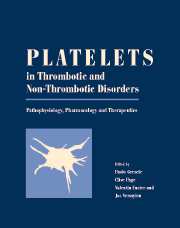Book contents
- Frontmatter
- Contents
- List of contributors
- Editors' preface
- PART I PHYSIOLOGY
- 1 History of platelets
- 2 Production of platelets
- 3 Morphology and ultrastructure of platelets
- 4 Platelet heterogeneity: physiology and pathological consequences
- 5 Platelet membrane proteins as adhesion receptors
- 6 Dynamics of the platelet cytoskeleton
- 7 Platelet organelles
- 8 Platelet receptors for thrombin
- 9 Platelet receptors: ADP
- 10 Platelet receptors: prostanoids
- 11 Platelet receptors: collagen
- 12 Platelet receptors: von Willebrand factor
- 13 Platelet receptors: fibrinogen
- 14 Platelet signalling: GTP-binding proteins
- 15 Platelet phospholipases A2
- 16 Roles of phospholipase C and phospholipase D in receptor-mediated platelet activation
- 17 Platelet signalling: calcium
- 18 Platelet signalling: protein kinase C
- 19 Platelet signalling: tyrosine kinases
- 20 Platelet signalling: cAMP and cGMP
- 21 Platelet adhesion
- 22 The platelet shape change
- 23 Aggregation
- 24 Amplification loops: release reaction
- 25 Amplification loops: thromboxane generation
- 26 Platelet procoagulant activities: the amplification loops between platelets and the plasmatic clotting system
- 27 Platelets and chemotaxis
- 28 Platelet–leukocyte interactions relevant to vascular damage and thrombosis
- 29 Vascular control of platelet function
- PART II METHODOLOGY
- PART III PATHOLOGY
- PART IV PHARMOLOGY
- PART V THERAPY
- Afterword: Platelets: a personal story
- Index
- Plate section
18 - Platelet signalling: protein kinase C
from PART I - PHYSIOLOGY
Published online by Cambridge University Press: 10 May 2010
- Frontmatter
- Contents
- List of contributors
- Editors' preface
- PART I PHYSIOLOGY
- 1 History of platelets
- 2 Production of platelets
- 3 Morphology and ultrastructure of platelets
- 4 Platelet heterogeneity: physiology and pathological consequences
- 5 Platelet membrane proteins as adhesion receptors
- 6 Dynamics of the platelet cytoskeleton
- 7 Platelet organelles
- 8 Platelet receptors for thrombin
- 9 Platelet receptors: ADP
- 10 Platelet receptors: prostanoids
- 11 Platelet receptors: collagen
- 12 Platelet receptors: von Willebrand factor
- 13 Platelet receptors: fibrinogen
- 14 Platelet signalling: GTP-binding proteins
- 15 Platelet phospholipases A2
- 16 Roles of phospholipase C and phospholipase D in receptor-mediated platelet activation
- 17 Platelet signalling: calcium
- 18 Platelet signalling: protein kinase C
- 19 Platelet signalling: tyrosine kinases
- 20 Platelet signalling: cAMP and cGMP
- 21 Platelet adhesion
- 22 The platelet shape change
- 23 Aggregation
- 24 Amplification loops: release reaction
- 25 Amplification loops: thromboxane generation
- 26 Platelet procoagulant activities: the amplification loops between platelets and the plasmatic clotting system
- 27 Platelets and chemotaxis
- 28 Platelet–leukocyte interactions relevant to vascular damage and thrombosis
- 29 Vascular control of platelet function
- PART II METHODOLOGY
- PART III PATHOLOGY
- PART IV PHARMOLOGY
- PART V THERAPY
- Afterword: Platelets: a personal story
- Index
- Plate section
Summary
Protein kinase C, a family of serine-threonine kinases
Protein kinase C (PKC) isozymes are a family of kinases that play an essential role in the signal transduction mechanisms after activation of receptors. Although with a different pattern of isozyme expression, these phospholipid- dependent kinases are present in every single cell type, including platelets. PKC isozymes phosphorylate multiple cellular proteins in serine and threonine residues leading to a plethora of effects on cell proliferation and death, differentiation, morphology and adhesion. In platelets, PKC isozymes control a variety of functions, including aggregation, release of granular contents, mobilization of intracellular calcium and regulation of cell shape. In addition, PKC isozymes play an important role in megakaryocyte differentiation.
PKC has been identified as the cellular receptor for the lipid second messenger diacylglycerol (DAG), and it is therefore a key enzyme in the signalling mechanisms after activation of receptors coupled to phospholipase C (PLC), a family of enzymes that leads to a transient elevation in membrane DAG levels. In addition, PKC isozymes are high affinity receptors for the phorbol ester tumour promoters, natural compounds which are the most common pharmacological activators of PKC both in vitro and in cellular systems. The higher potency of phorbol esters and their greater stability compared to the second messenger DAG make these compounds the preferred activators of PKC in experimental models. Because of the limitations of platelets as a system for genetic studies, pharmacological tools have been widely used in these cells.
- Type
- Chapter
- Information
- Platelets in Thrombotic and Non-Thrombotic DisordersPathophysiology, Pharmacology and Therapeutics, pp. 272 - 280Publisher: Cambridge University PressPrint publication year: 2002
- 2
- Cited by



